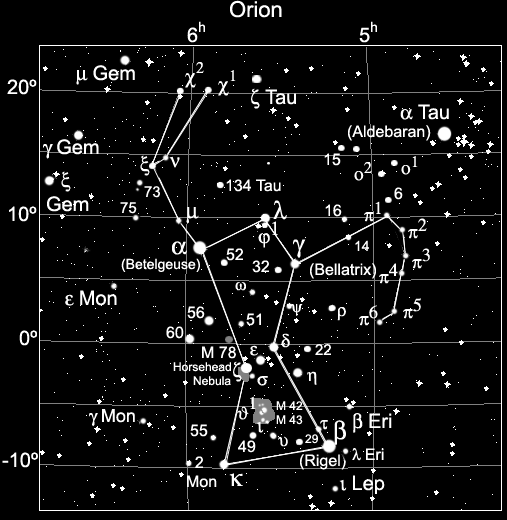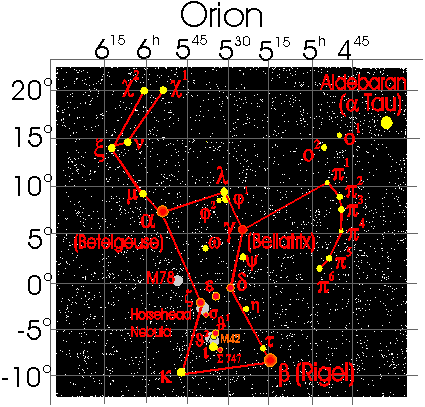
Orion is Winter's most dominant constellation, arriving late Autumn and not leaving until early Spring. While there are many objects here suitable for medium or large telescopes, binoculars can at least allow one to locate these intriguing DSOs.

alpha Orionis has perhaps the most famous star name in the heavens, Betelgeuse, which is a distortion of the Arabic for "Armpit of the Central One". The star is a red supergiant, the brightest variable star in the heavens. It may go from a brightness of 0.3 (nearly as bright as Rigel) to 0.9 (about the same brightness as Aldebaran, alpha Taurus, to the northeast. These two stars, then, are excellent guides by which one might make visual comparisons to Betelgeuse.
Since antiquity the star has formed the right shoulder (or armpit) of Orion. In binoculars, if you place Betelgeuse at the centre of your FOV then you will see two fairly bright stars in the same area, one to the northeast and one to the southwest. The star to the northeast is mu Orionis, while to the southwest is 52 Orionis. Both are binaries, but you are not expected to be able to split them with binoculars.
With these three stars in your FOV you can begin to judge their relative visual brightness. Betelgeuse is a very bright 0.45, while mu Orionis is 4.1, and 52 Orionis binary is 5.3 (the combined value of the binaries).
beta Orionis (Rigel), Orion's left foot or leg, is the brightest star in the constellation. In fact the name 'Rigel' means 'Left Leg'. The star is a binary (Struve 668) with a 7th mag visual companion 9.4" from the primary at a position angle of 202º. The binary has a slight colour contrast, a bluish-white supergiant and blue companion. Due to the brightness of the primary you won't be able to resolve the binary with binoculars. It takes a large telescope to split the two. However, there is plenty here to see! With Rigel at the centre of your FOV, you'll note four other bright stars, two to the northeast, one to the north-northwest, and one to the southwest.
To the north-northeast is tau Orionis (with faint companion) while more to the east of Rigel is 29 Orionis. Tau Orionis has a visual magnitude of 4.6, while 29 Orionis is 4.1. This is exactly one-half a magnitude difference; do you notice the difference? Take your time, study the two for a while and see if you can tell that one is somewhat brighter than the other. This 'somewhat' is exactly half a magnitude.
Now, if a difference of one magnitude means a brightness difference of 2.5 times, a star with a half-mag difference would have a brightness difference of 1.6. Thus tau Orionis is a bit more than one and a half times brighter than 29 Orionis.
Delta Orionis (Mintaka: "The Belt") forms the left end of Orion's belt (or right-most of the three central stars as we look at them). The three stars of the belt follow the Greek alphabet: delta, epsilon, zeta, and are great views in binoculars as all three nicely fit in the same field of view. Delta is a fine binary with several companions, the brightest of which (companion D) is 0.53" due north (i.e., at a position angle of 360º). It takes at least 10x binoculars to resolve the binary.
Epsilon Orionis (Alnilam, "String of Pearls") is the central star in the belt and the brightest at 1.7. Alnilam is intrinsically much brighter than the other two, but at an increased distance of 412 light years it appears equal in brightness. The bright (5.4) eclipsing variable VV Orionis is just to the west of Alnilam (about half-way to Mintaka)
Gamma Orionis (Bellatrix: The Female Warrior) is appropriately found on the Hunter's left (distaff) shoulder, or on the upper right corner of Orion to an observer. Studying this region with binoculars, you'll find that there are several stars to the north and a single bright star to the southeast. North are lambda (binary with combined mag of 3.4), phi-1 and phi-2, both 4th-mag stars. Finally, to the southeast is 32 Orionis, a 5.5 visual magnitude. Thus you have a range of magnitudes, from 3.4 to 5.5, and just how well you can see these various stars with the naked eye gives you a good idea of the quality of your night skies.
To finish the names of the four corners of Orion, to the east is of course Betelgeuse while down at the lower left, Orion's right foot, is Saiph ("Sword", kappa Orionis), another blue-white supergiant.
Bellatrix is a convenient starting point to find Aldebaran, the eye of the bull in the neighbouring constellation of Taurus. Using thumb and forefinger find the apparent distance of Bellatrix to Rigel At the same apparent distance to the northwest of Bellatrix is found Aldebaran. Starting at zeta Orionis, in the same FOV to the southwest is sigma Orionis (3.7 combined visual mag).
Sigma Orionis is a multiple binary with one very close companion and two wider ones. While a small telecope would be of better use to fully enjoy the spectacle, its brightest companion should be visible in binoculars. The bluish-white primary (3.7) star has a bluish companion (6.7 separation 42" at PA 61º) which you might be able to resolve, and a reddish one (6.9, PA 84º and separation 12.9") which will require a scope.
Theta1 Orionis is a celebrated multiple star system in the middle of The Orion Nebula system which goes by the name of ‘The Trapezium’. It is the illumination provided by these multiple members of theta Orionis that the nebula has become one of the most popular in the heavens. If you place zeta, the eastern-most star of the belt, at the top of your FOV, then the nebula and the theta1 Orionis complex will be centred.
The four stars which make up ‘The Trapezium’ (J1A, J1B, J1C, and J1D) require large instruments to be fully appreciated. The J1 system forms another binary system with J2. As the companion is a very wide 135" from the primary, it is easily split with any binoculars.This companion, J2, is an interesting multiple binary of its own: the companion B is a 6.4 mag star found 53" away at a position angle of 92º (that is, nearly due west). You should be able to split the two with binoculars. The much fainter companion C, 8.5, is also to the west at 98º and a separation of 129".
Zeta Orionis (Alnitak: The Girdle) is a blue-white supergiant. Alnitak is a multiple binary with a 4th-mag companion (difficult in binoculars) as well as a very faint 10th magnitude companion. Like epsilon, zeta is surrounded by a gaseous nebula, difficult to see in binoculars. Indeed, the famous 'Horsehead Nebula' is found just south of the star, but not even telescopes bring out its texture. Long-exposure photography is needed. The entire belt easily fits in one binocular view.
Just southwest of zeta is sigma and below this, right at the bottom left, is the complex known as the Great Orion Nebula, one of the most fascinating objects in the heavens.
